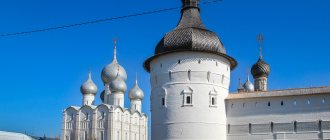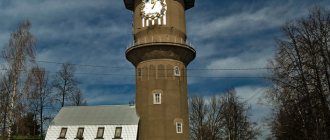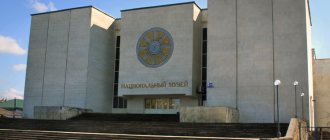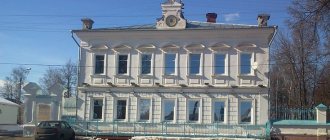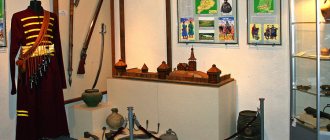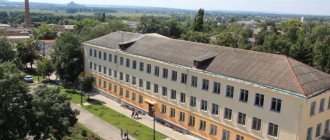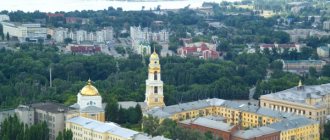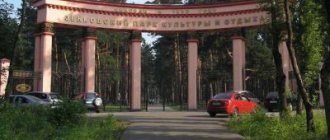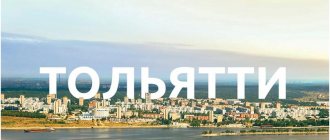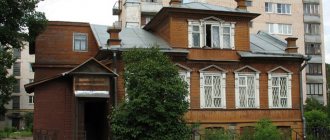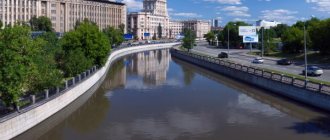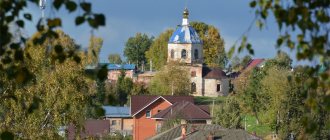In Russia, as you know, there are two Rostovs. One is located northeast of Moscow, and is called Velikiy. The second one in the south is Rostov-on-Don. Both cities are interesting in their own way. But other than the name, there is not much in common between them.
Veliky Rostov is a small and patriarchal settlement, which is a pleasant contrast to the ever-rushing Moscow. All its antiquities can be seen in a few hours.
The southern namesake is a million-plus city with huge residential areas, a lot of cars, and an extensive road network. And a much larger number of temptations.
The first one likes to get lost in the shadow of the second one - just type the name into the search without specifying it. But among knowledgeable people it is even more popular. Of course, this is the city of the “Golden Ring of Russia”. While not claiming to be the capital of the famous tourist route, Yaroslavl need not be afraid. But definitely a settlement with an aura!
What surrounds the Golden Circle
The most prominent landmark is the Rostov Kremlin. Which has long been listed as a candidate for inclusion in the UNESCO World Heritage List. And he has a good chance of getting there. The international organization is unlikely to take it into account, but
- It was along the covered passages of the Kremlin that the heroes of the cult Soviet comedy “Ivan Vasilyevich Changes His Profession” ran, fleeing from the Streltsy
How to get there
The journey from the capital by private car or excursion bus takes just over 3 hours. A fast train from Moscow to Yaroslavl (departure at 7.35) will cover the distance in 2.5 hours. The Arkhangelsk squad (10.05) will spend ~3'40.
A ticket with meals in a seated carriage costs ~1,500 RUB. It is, of course, better to buy in advance: on the eve of May Day and other holidays, not to mention the New Year holidays, nothing will be in stock.
It’s even more convenient to travel by car! And not because you can get from the capital in just 3-4 hours (215 km). But because, theoretically, you can independently design an interesting excursion route. Including a visit to Pereslavl-Zalessky, an overnight stay in Rostov and a stopover - for a day or two - in Yaroslavl. The distance between the designated cities is literally ridiculous - from 65 to 55 km!
What you can see in Yaroslavl
What to bring from Rostov
Enamel
About enamel, I think everything is clear. Good products with enamel are real works of art.
There is a lot of enamel in Rostov and it is expensive, although some simple jewelry is sold for 300 rubles or even cheaper. But something really beautiful, for example a box, costs from 1000 rubles.
It is better to buy in a store at an enamel factory, although you can also buy small items in souvenir shops around the Kremlin.
Bell
Some time ago, a popular Rostov souvenir was a clay bell. Now they are no longer so popular. There is nothing special about the bells, they just remind you of the large Sysaya bell that hangs in Rostov.
Ceramics
You need to buy black-polished ceramics. It looks just matte black, without glaze. This color is obtained by smoking products in smoke.
Where to stay
You can spend the night in Rostov the Great not only in an ordinary hotel or apartment - the Trinity-Sergius Varnitsky Monastery will also gladly accommodate city guests. However, don’t count on private rooms. And you will have to get to the city center!
But staying at the guest house “On Valakh”, you can walk to the entrance to the local Kremlin in 3-4 minutes. The house is decorated in traditional Russian style and is very well maintained. The rooms have a standard set of amenities and even more: a refrigerator and microwave.
In a beautiful location right on the shore of Lake Nero there is a brand new hotel with the not-so-Russian name Bravis Holiday Park. But those who stayed praise the cleanliness of the rooms and the views from the windows. And the presence of a good restaurant is an important bonus for a traveler who is tired from the road.
Architectural and artistic ensemble of the former Spaso-Yakovlevsky Monastery
Architectural and artistic ensemble of the former Spaso...
Rostov
Panorama of the Spaso-Yakovlevsky Monastery is one of the most picturesque views of Rostov the Great. It combines architectural forms of different styles - classical and baroque church completions, pseudo-Gothic towers.
The monastery was founded by the Rostov bishop Jacob back in the 14th century - he cut down a small wooden temple south of the city. Later, a whole monastery was formed around the church. At the end of the 18th century, the first stone building appeared here - the Trinity Cathedral (the future Conception Cathedral), which was consecrated by the Rostov Metropolitan Jonah Sysoevich. Currently, there are three temples on the territory of the monastery - the Yakovlev Church, the Conception and Demetrius Cathedrals.
Sights of Rostov
Assumption Cathedral and belfry. Located near the Rostov Kremlin. The cathedral was built in the 16th century on the site of a much older church that burned down. The concept is traditional for the architecture of the Vladimir-Suzdal principality: a five-domed temple, an arcaded pattern of walls.
The belfry is almost two centuries younger, but is known even more. Each of the 13 bells has its own sound, and together they are capable of beating dozens of acoustic pieces. They work together like your orchestra, amazing with the variety of available melodies.
The largest bell weighs 32 tons, but who weighed it? But you can listen for a long time... Until they invite you back onto the bus. Yes, you may have heard: in the same “Ivan Vasilyevich” Yuri Yakovlev created what melodies!
- Excursion to Rostov the Great and Pereslavl-Zalessky
In atheistic Soviet times, she released the album “Rostov Bells,” which became a hit and was then reissued many times.
Rostov Kremlin
Another prominent landmark of the ancient city. It was originally created as the residence of the metropolitan, which fundamentally distinguishes it from other Russian fortresses. It was built at the end of the 17th century. And although it followed the tradition and looks like a citadel, it never had defensive significance.
This does not spoil it - we agree. Who, really, will count the loopholes and pay attention to other nuances? The Rostov Kremlin looks interesting - it is an example of the peculiar architectural eclecticism of pre-Petrine times. And according to Russians, it is one of the symbols of the country, very recognizable!
In general, the city is like a textbook on the history of Russia. And if you spend a little bit of your time and a little money, it will literally start playing. Scant information from a school textbook is one thing. The story of an erudite man in love with his “small” Motherland is completely different: rostov-velikiy-zhivaya-istoriya-drevnego-goroda.
The Kremlin, by the way, still retains the status of a state museum and is not under the jurisdiction of the Russian Orthodox Church. During the visit, you can explore a number of churches, premises for various purposes, as well as a collection of religious art.
Entrance inside costs 70 RUB, and then everything depends on your interests. The most intense program includes a walk along the walls, visits to churches and the Museum of Church Antiquities - a ticket will cost 220 rubles. By the way: you are allowed to climb and wander along the walls only from May 1 to October 1: www.rostmuseum.ru/posetitelyam/stoimost-biletov/.
A huge collection of painted enamels (more than 3,000 units) was collected by the enamel museum located on the territory of the Kremlin. Rostov enamel is a brand known for more than 250 years, one of the emblems of the city and region.
Dimitriev Monastery
For tourists who are not constrained by time constraints, we recommend taking a look from the inside at the Spaso-Yakovlevsky Dimitriev Monastery of the 14th century. In 1991, the monastery was returned to the church and brought back to normal. Excursions are provided for pilgrimage groups.
Individual visitors can also enter the territory. And they obviously won’t regret it: the monastery is large, beautiful and located in a very good location, right on the shore of Lake Nero. While walking along the walls, you will stop more than once to enjoy the views.
Museum of Rostov Merchants
Located in a cozy mansion on Leninskaya Street, 32 - it’s a 5-7 minute walk from the Kremlin. Inside there is an exhibition dedicated to the local merchant family of the Kekins. But it tells in general about the history, traditions and life of the Rostov merchants.
For some reason the museum is not open on Mondays and Tuesdays... Or is the flow of people too small?
Museum-Reserve "Rostov Kremlin"
Rostov-Yaroslavl Museum of Architecture and Art…
Rostov
In 1883, the Museum of Church Antiquities opened in the White Chamber of the Rostov Kremlin; later it received the status of an all-Russian museum. The Kremlin has finally lost its religious function, but the presence of a museum on its premises has made it possible to preserve the architectural ensemble of the former residence.
Today, the Rostov Kremlin Museum-Reserve displays more than 180 thousand valuable exhibits, among them ancient Russian icons, Yam bells, and an altar cross from the 16th century. Here is the largest collection of enamel items in Russia - about 2.5 thousand miniatures from the 18th to 20th centuries.
What to see in the area
The wooden church in the village of Bogoslov, located 3 kilometers from the city center, is the only one preserved in the Yaroslavl region. The 17th century is a celebrity of its own: the famous artist Vasily Vereshchagin painted a couple of paintings inside. It seems that Emperor Nicholas II visited the village and church while passing through.
The Church of St. John the Evangelist today is a branch of the Yaroslavl Museum-Reserve and is open to visitors only from May to October. Monday-Tuesday is traditionally a weekend.
Note that just 58 km northeast on the banks of the Volga lies another magnificent Golden Ring city, Yaroslavl. Approximately 130 km along the highway to Kostroma - that's less than 3 hours' drive if by car!
Textile ]Ivanovo[/anchor] is also located at approximately the same distance! “City of Brides” and two wonderful museums: chintz and local history. The first is located in the mansion of local industrialist and philanthropist D.G. Burylin, and the second - in a building specially built by him. Visitors are offered a rich collection of various items.
© Eurotraveler.ru
Museum of Rostov Merchants
Museum of Rostov Merchants
Rostov
The Museum of Rostov Merchants is located in the building of a merchant estate of the late 18th - early 20th centuries. A family of merchants, the Kekins, lived here from 1835 until the revolution.
The exhibition “Kekins - Family, Fate, Heritage” introduces the history of several generations of a famous family. Using the example of the life of the Kekins, one can trace the culture of the entire Rostov merchant class. The interiors of the living room, dining room, office and boudoir are recreated here. The exhibition presents personal belongings, picturesque portraits and photographs of the Kekin family.
Where to eat in Rostov
Meeting
In the Kremlin, in the Red Chamber.
There is a Sobranie restaurant in the Red Chamber, but it is more for corporate events than for individual relaxation. Everything is somehow big and uncomfortable. We had lunch here once - not good, not bad. The service is slow, they may forget what you ordered, and I didn’t like how they react to criticism. They brought a cold dish, when I asked to warm it up, they made a strange expression on their face and tried to convince me that it was necessary.
The food is delicious. But service can ruin the experience. I got the feeling that the restaurant lives off of corporate events and large groups of tourists (buses are taken here), and they have given up on individual visitors.
Open from 10:00 to 23:00.
Alesha Popovich
There is Russian cuisine, interior, and you can dress in chain mail.
The first one is on Tripadvisor, you can check it out. I haven’t been here, for some reason I didn’t like the facade of the restaurant, although I knew that they had a high rating.
I advise you to come here. I read all the negative reviews and several dozen positive ones. I liked that the administration does not ignore criticism, this is a good sign. We have already written that there are a lot of custom reviews on Tripadvisor. Not everyone can be trusted.
When I'm in Rostov next time, I'll definitely come here and tell you about my impressions.
Places for walking
Cathedral Square
Address: Rostov Kremlin
The main square of Rostov the Great is called Cathedral and is located in the heart of the Rostov Kremlin. In ancient times, it served as a gathering place for the people's meeting, where important city problems were resolved and discussed, courts were held, and trade was conducted. Frequent fires changed the size and outline of the square, but its significance as the city center remained unchanged.
At the turn of the 17th-18th centuries, the square was surrounded by a stone wall, and it became part of the Kremlin. Therefore, now, in order to take a walk and enjoy the picturesque views of the churches, you need to visit the Rostov Kremlin.
Lake Nero
How to get there: by car along the street. Spartakovskaya
The unusual name of Lake Nero excites the minds of many city guests. There is a legend that one traveler heading to Rostov lost his way and wandered through the local swamps for several days. When, exhausted from fatigue and hunger, he finally saw the domes of the Rostov churches, he exclaimed: “This is not Ro...”, but before he could finish speaking, he fell struck by an arrow. Since then, the ancient lake began to be called “Nero”
The first people to populate the shores of the lake were the Finno-Ugric peoples. In the 9th century, these places also attracted the attention of the Eastern Slavs, who gave the lake the nickname Rostov. However, the name did not catch on; people continued to call the reservoir “Nero”, which translated from Finno-Ugric means “muddy, swampy place”.
The waters of Nero have been a favorite place for fishermen for several centuries. Today there are also boat and steamship excursions on the lake.
City Park
Address: City Park Telephone: 8 (48536) 6-05-91 Opening hours: 10:00-22:30 Tue.-Sun., Mon. — day off Cost: free
You can admire the water surface of Lake Nero and just have a pleasant rest in the city park. It begins its history in the first half of the nineteenth century. At one time, there were gazebos, a wooden circus and a theater here. A pier for pleasure boats was also built in the park.
In 2012, the City Garden underwent a large-scale reconstruction, which made this place even more attractive and convenient for a pleasant pastime.
Population
Rostov presents a rather amazing picture for residents of large cities. After all, even the population growth over the past five years has not brought the city to a new level. According to sociologists, at the end of 2016, 30,943 people lived in Rostov. This figure is stable, and fluctuations in numbers are mainly caused by an increase in the birth rate and a decrease in mortality in the city.
In addition, the average life expectancy in Rostov is 75 years, which is much higher than the national average. This fact is associated with a good environmental situation and the absence of large industrial enterprises in the city.
General information for tourists
The city of Rostov the Great is located on the Northern Highway, so getting here by train from anywhere in the country will not be a problem.
Another thing is that if you travel from St. Petersburg, you will have to change trains. The same applies to the most accessible method of transportation from Moscow – electric trains. You will have to make a transfer in Aleksandrov, spending a total of at least five hours on the road. It is better to go to the Yaroslavl station and buy a ticket for a passenger train. It costs several times more, but you will get directly to your destination in a comfortable carriage in a maximum of four hours. Another option for getting to Rostov is buses. Several flights leave from Moscow per day in different directions, going through Rostov; buying a ticket is not at all a problem right before departure. If you go by private car, then excluding traffic jams, the journey by car will take no more than 3 hours.
In any case, you will not have time to leave on the same day - the road is not close, and there are many attractions. Experienced tourists recommend thinking about spending the night before leaving. Hotels in Rostov offer the most ordinary rooms at not the cheapest prices, and even you can’t always get them - in the high season, with an influx of tourists, hotels and guest houses are overcrowded. But don’t despair - there is always the opportunity to get an overnight stay at one of the tourist bases in the vicinity of Rostov. At the same time, you can organize a fishing trip or a picnic in nature, completely isolated from civilization. And if you wish, you can stay in the chambers of a real noble estate with a beautiful view of the lake from the windows.
Trinity Sergius Varnitsky Monastery
A few kilometers from Rostov in 1427, on the site where Sergius of Radonezh had previously been born and raised, local Archbishop Ephraim founded a temple. Initially, the building was wooden, and only by the middle of the 18th century, thanks to the funds of Bishop Afanasy Volsky, it became stone. Later, with donations from Rostov merchants, the Winter Church and the Church of the Presentation were built.
During the Soviet era, the monastery was almost completely destroyed, and only the Vvedenskaya Church and a few cells survived.
Since 1995, during the process of restoration work, the monastery was practically rebuilt, bringing the architecture of the building as close as possible to its original appearance.
Population density and ethnic composition
At the moment, the residents of Rostov are represented mainly by Russians. They make up more than 95% of the city's population. The remaining 5% was almost evenly distributed among the nations that came here from other regions of Russia. They do not constitute a static value, so they are rarely taken into account in official data.
The population density is 1,970 people per square kilometer, which is quite average in the country among cities with a population of less than one hundred thousand people.
Rostov-on-Don: population
As we have already clarified, for many years it has been classified as a million-plus city. To be more specific, we can say that already in the eighties of the last century Rostov-on-Don crossed the line of one million inhabitants and officially joined the ranks of special megacities.
At the moment, the population of Rostov-on-Don is 1,125,103 people. An impressive figure, isn't it? According to the indicator, the city ranks tenth in the country, behind the recognized leaders Moscow and St. Petersburg, as well as several other cities. Sociologists believe that if population growth does not stop, then in fifteen years Rostov will be in the top five cities on this list. In Europe, this Russian city ranks thirtieth in terms of population.
It is worth clarifying that the figure characterizing the population of Rostov-on-Don is more than 20% of all residents of the region. We can say that every fifth person in the region lives in this metropolis. Many analysts attribute this to the abundance of jobs, because quite often people move here from villages and nearby small towns in search of a better life. Be that as it may, the city fully justifies its title of “the southern capital of Russia.”
Assumption Cathedral
The exact date of construction of the Assumption Cathedral, which is part of the Rostov Kremlin complex, cannot be established; the temple burned and was rebuilt many times; the brick building of the cathedral from 1512 has survived to this day. Next to the temple there is a belfry. The largest of the 15 bells weighs 32.7 tons.
Inside the cathedral, frescoes from the 16th–17th centuries found during restoration, an iconostasis in the Baroque style, and the relics of Rostov saints and ruling bishops are preserved.
Boris and Gleb Monastery
The Boris and Gleb Monastery will be encountered by those traveling along the “Golden Ring” on the road between Rostov and Uglich. The construction of the temple began in 1363 by the hermits Paul and Feodor, who received the blessing of Sergius of Radonezh. This monastery was especially loved and often visited by Moscow princes, and therefore was richly maintained. A large number of believers coming to the monastery from all sides also attracted merchants with their goods. So around the Borisoglebsky monastery a large village arose - Borisoglebsky settlements, where holiday fairs were often held.
Under Soviet rule, the People's Museum was opened in the monastery. In 2015, all of its property was returned to the monastery. The Boris and Gleb Monastery houses many Orthodox shrines that can perform miracles, give hope and heal believers.
“The Southern Capital of Russia”: general characteristics
In the south of our country, Rostov-on-Don is one of the largest and most beautiful cities. Now it is rightfully considered a million-plus city. And his official history dates back to the mid-eighteenth century, and throughout his existence he has repeatedly appeared in a heroic light.
Now the city is the cultural, historical and administrative center of the southern region. It is simply impossible to come to Rostov-on-Don and remain indifferent to it. The city captivates you literally at first sight. Moreover, every year it becomes more and more beautiful and comfortable. Six years ago, Rostov was placed in fifth place in the ranking of cities with a high quality urban environment. The population of this wonderful metropolis is proud not only of the heroic past of their city, but also of its present, filled with brilliant prospects.
For example, next year this city will host the World Cup. This means that in the near future Rostov-on-Don will become even more beautiful and will receive a powerful impetus for further development.
Lake Nero
It’s worth starting with the lake, because it’s everywhere here, and it appeared much earlier than the town itself. Scientists believe that the lake is at least 500 thousand years old. But this is not the only thing that makes the reservoir unique. Firstly, people cannot swim in it because of the muddy bottom and muddy water - in some places the thickness of the silt layer reaches 20 meters. Secondly, as many as 17 rivers flow into it, but only one flows out. And thirdly, perhaps, under its dark waters, in the muddy layers, the legendary city of Kitezh and the golden treasures of ancient monks are buried. So far no one has found them, but the excitement has not subsided for decades.
The lake itself is small and shallow, its area is just over 50 square meters. km, and the depth only in some places reaches three meters. This place is not for swimming and not for full-fledged navigation, except for fishing and trips on a light boat. By the way, catching a pike here, and not the usual bream or carp, means earning the respect of local old-timers and experienced fishermen, since the pike in Lake Nero are very cunning. Remember this when you are served the rich Rostov soup made from it, hand-made dumplings with minced pike, and the head, a royal delicacy, on a separate dish, with a garnish of salted boletus mushrooms.
